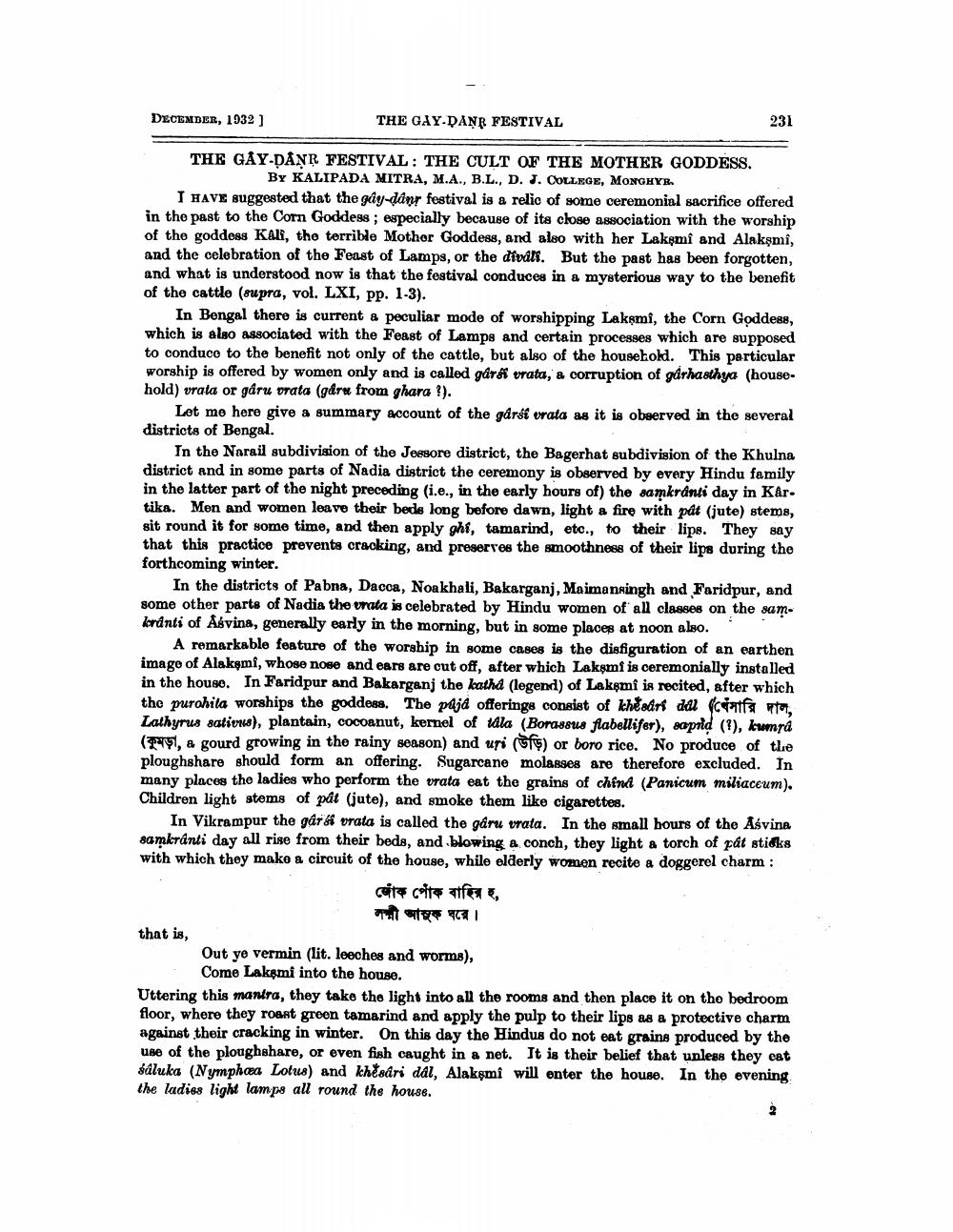________________
DECEMBER, 1932 ]
THE GAY-DANR FESTIVAL
231
THE GAY-DAŅR FESTIVAL : THE CULT OF THE MOTHER GODDESS.
BY KALIPADA MITRA, M.A., B.L., D. J. COLLEGE, MONGHYR I HAVE suggested that the gay-dánr festival is a relic of some ceremonial sacrifice offered in the past to the Corn Goddess ; especially because of its close association with the worship of the goddess Kali, the terrible Mother Goddess, and also with her Lakşmi and Alakşmi, and the celebration of the Feast of Lamps, or the divdll. But the past has been forgotten, and what is understood now is that the festival conduces in a mysterious way to the benefit of the cattle (supra, vol. LXI, pp. 1-3).
In Bengal there is current a peculiar mode of worshipping Lakşmi, the Corn Goddess, which is also associated with the Feast of Lamps and certain processes which are supposed to conduce to the benefit not only of the cattle, but also of the household. This particular worship is offered by women only and is called gari urata, a corruption of gárhasthya (household) vrata or gáru vrata (garu from ghara ?).
Let me here give a summary account of the garší vrata as it is observed in the several districts of Bengal.
In the Narail subdivision of the Jessore district, the Bagerhat subdivision of the Khulna district and in some parts of Nadia district the ceremony is observed by every Hindu family in the latter part of the night preceding (i.e., in the early hours of) the samkrants day in Kar. tika. Men and women leave their bede long before dawn, light a fire with pát (jute) stems, sit round it for some time, and then apply ghi, tamarind, etc., to their lips. They say that this practice prevents cracking, and preserves the smoothness of their lips during the forthcoming winter.
In the districts of Pabna, Dacca, Noakhali, Bakarganj, Maimansingh and Faridpur, and some other parts of Nadia the nata is celebrated by Hindu women of all classes on the samkordnti of Asvina, generally early in the morning, but in some places at noon also.
A remarkable feature of the worship in some cases is the disfiguration of an earthen image of Alaksmi, whose nose and ears are cut off, after which Lakşmi is ceremonially installed in the house. In Faridpur and Bakarganj the katha (legend) of Lakşmi in recited, after which tho murohita worships the goddess. The pujà offeringe consist of the odrf ddl (cinta at. Lathyrus sativus), plantain, cocoanut, kernel of vla (Borassus flabellifer), saprld (?), kumrá (TYT, & gourd growing in the rainy season) and uri (15) or boro rice. No produce of the ploughshare should form an offering. Sugarcane molasses are therefore excluded. In many places the ladies who perform the vrata eat the grains of chini (Panicum miliaceum). Children light stems of pát (jute), and smoke them like cigarettes.
In Vikrampur the går i vrata is called the gáru vrata. In the small hours of the Asvina samkranti day all rise from their beds, and blowing a conch, they light a torch of pát sticks with which they make a circuit of the house, while elderly women recite a doggerel charm :
cire coit af ,
* 161 that is,
Out ye vermin (lit. leeches and worms),
Come Lakşmi into the house. Uttering this mantra, they take the light into all the rooms and then place it on the bedroom floor, where they roast green tamarind and apply the pulp to their lips as a protective charm against their cracking in winter. On this day the Hindus do not eat grains produced by the use of the ploughshare, or even fish caught in a net. It is their belief that unless they cat saluka (Nymphæa Lotus) and kněsdri dal, Alakşmi will enter the house. In the evening the ladies light lampe all round the house.




